Abstract
1. The binding properties of human platelet A2a adenosine receptors, assayed with the A2a-selective agonist, [3H]-2-[p-(2-carboxyethyl)-phenethylamino]-5'-N-ethylcarboxamidoad enosine ([3H]-CGS 21680), are masked by a non-receptorial component, the adenotin site. In order to separate A2a receptors from adenotin sites, human platelet membranes were solubilized with 1% 3-[(3-cholamidopropyl)dimethyl-ammonio]-1-propanesulphonate (CHAPS). The soluble platelet extract was precipitated with polyethylene glycol (PEG) and the fraction enriched in adenosine receptors was isolated from the precipitate by differential centrifugation. 2. The present paper describes the binding characteristics of the selective A2a agonist, [3H]-CGS 21680, to this purified platelet membrane preparation. In addition, receptor affinity and potency of several adenosine agonists and antagonists were determined in binding and adenylyl cyclase studies. 3. Saturation experiments revealed a single class of binding site with Kd and Bmax values of 285 nM and 2.07 pmol mg-1 of protein respectively. Adenosine receptor ligands competed for the binding of 50 nM [3H]-CGS 21680 to purified protein, showing a rank order of potency consistent with that typically found for interactions with the A2a adenosine receptors. In the adenylyl cyclase assay the compounds examined exhibited a rank order of potency very close to that observed in binding experiments. 4. Thermodynamic data indicated that [3H]-CGS 21680 binding to the purified receptor is totally entropy-driven in agreement with results obtained in rat striatal A2a adenosine receptors. 5. It is concluded that in the purified platelet membranes there is a CGS 21680 binding site showing the characteristic properties of the A2a receptor. This makes it possible to use this compound for reliable radioligand binding studies on the A2a adenosine receptor of human platelets.
Full text
PDF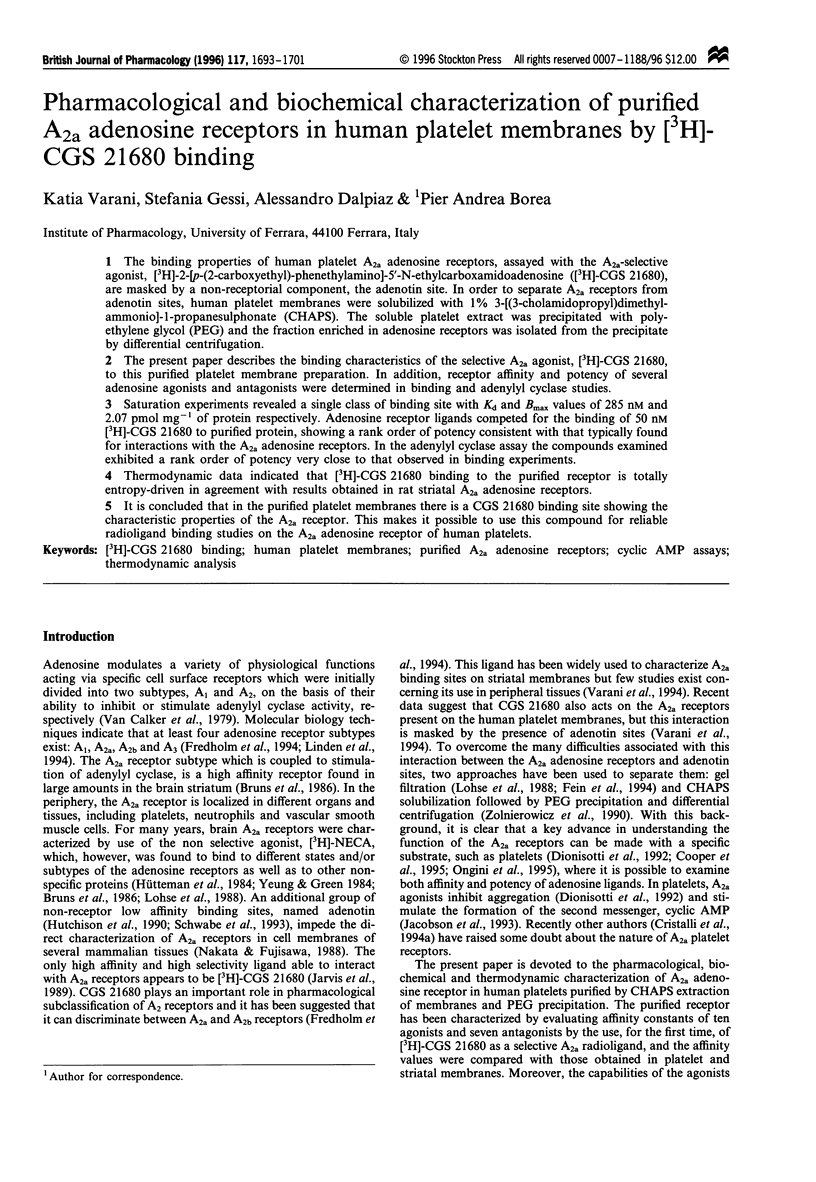
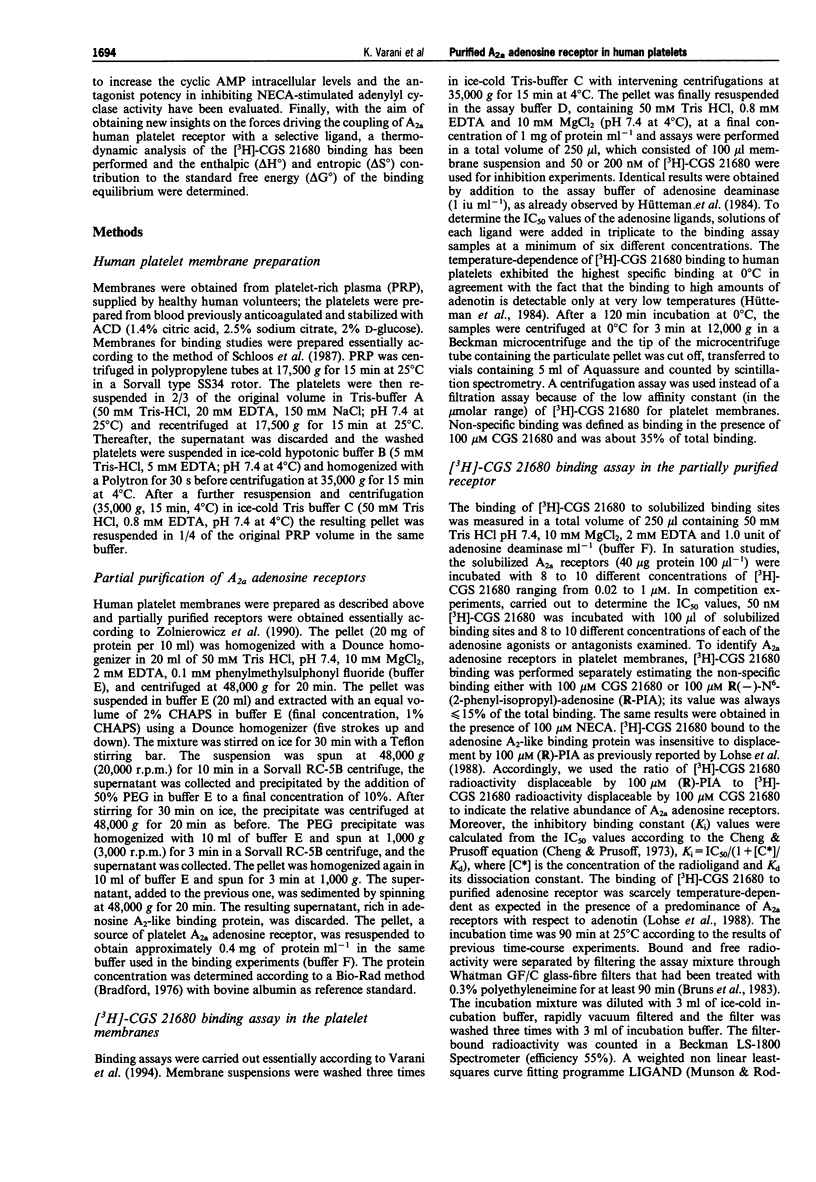
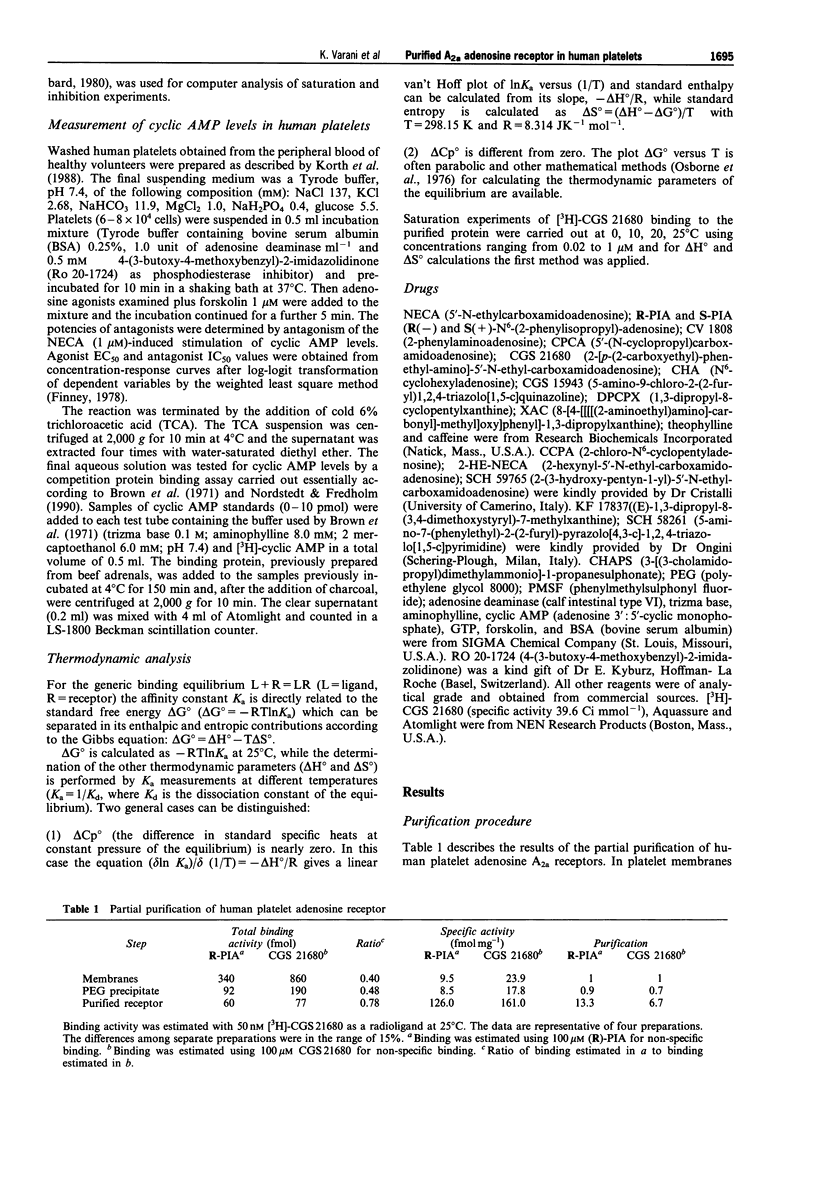
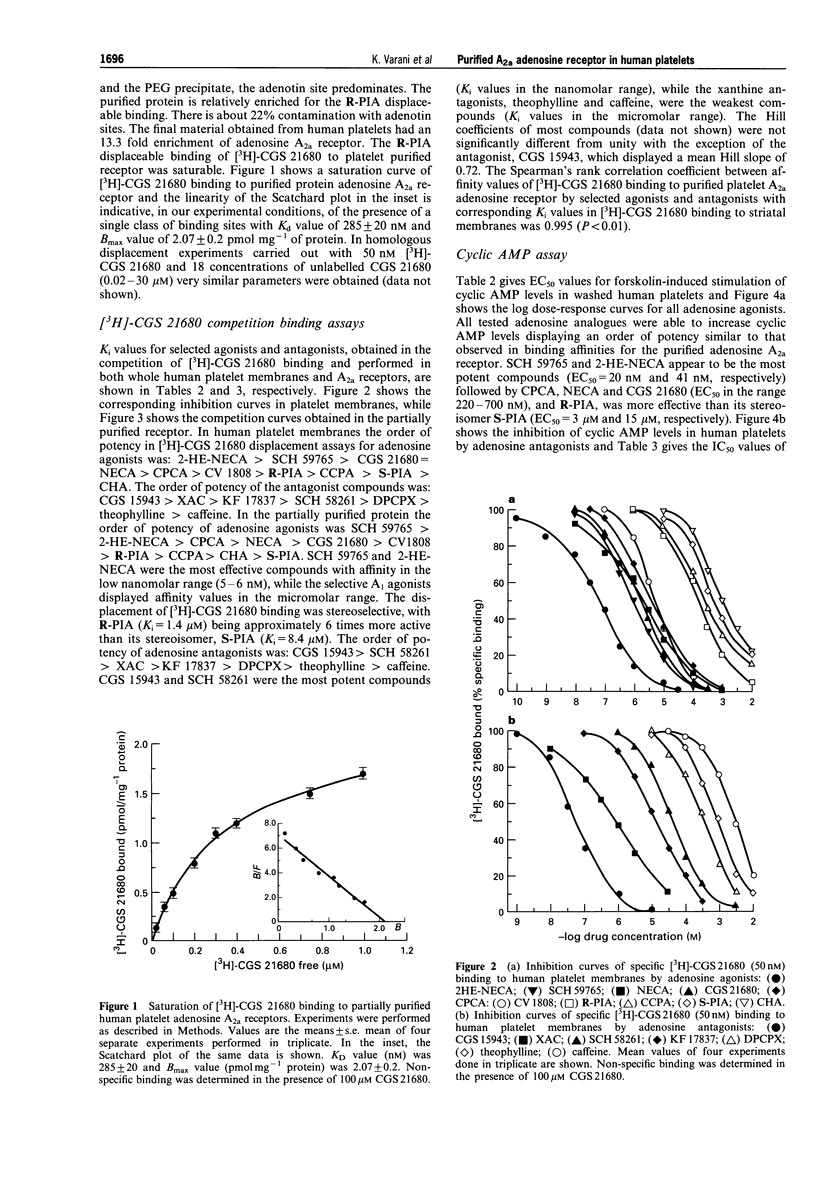
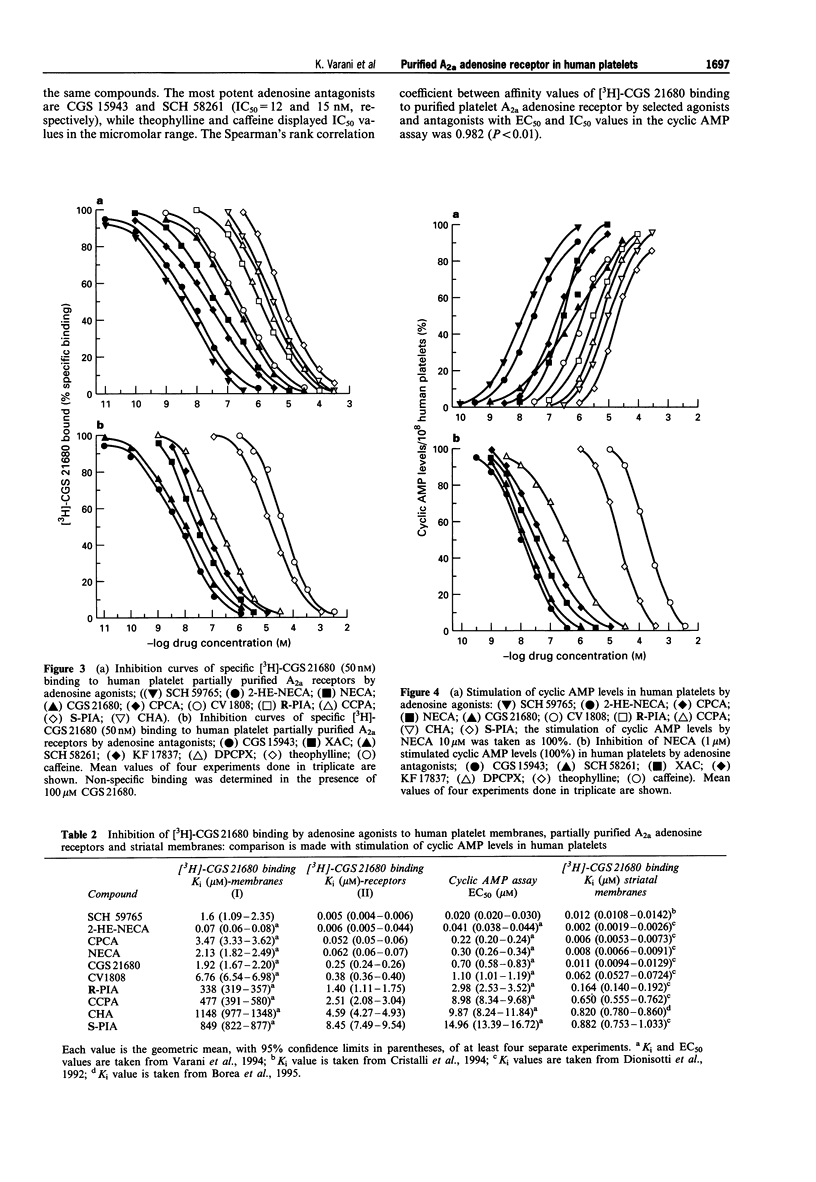
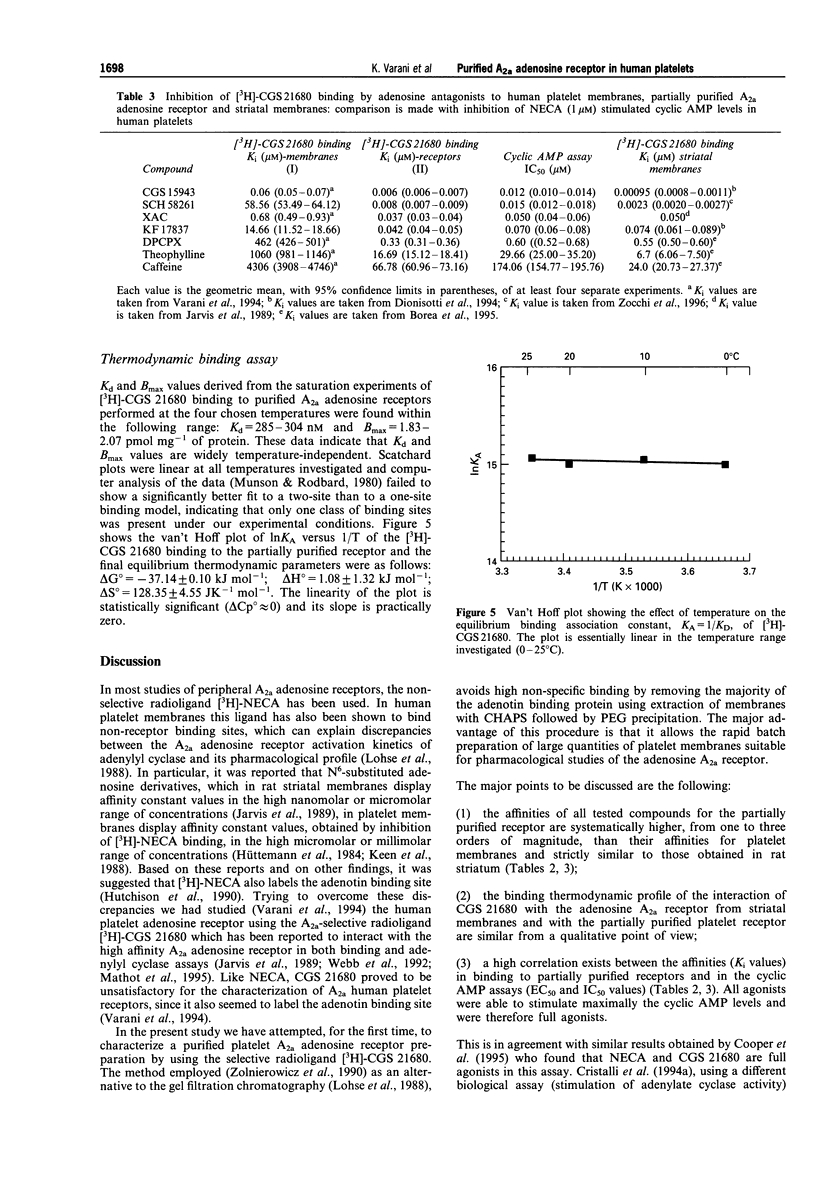
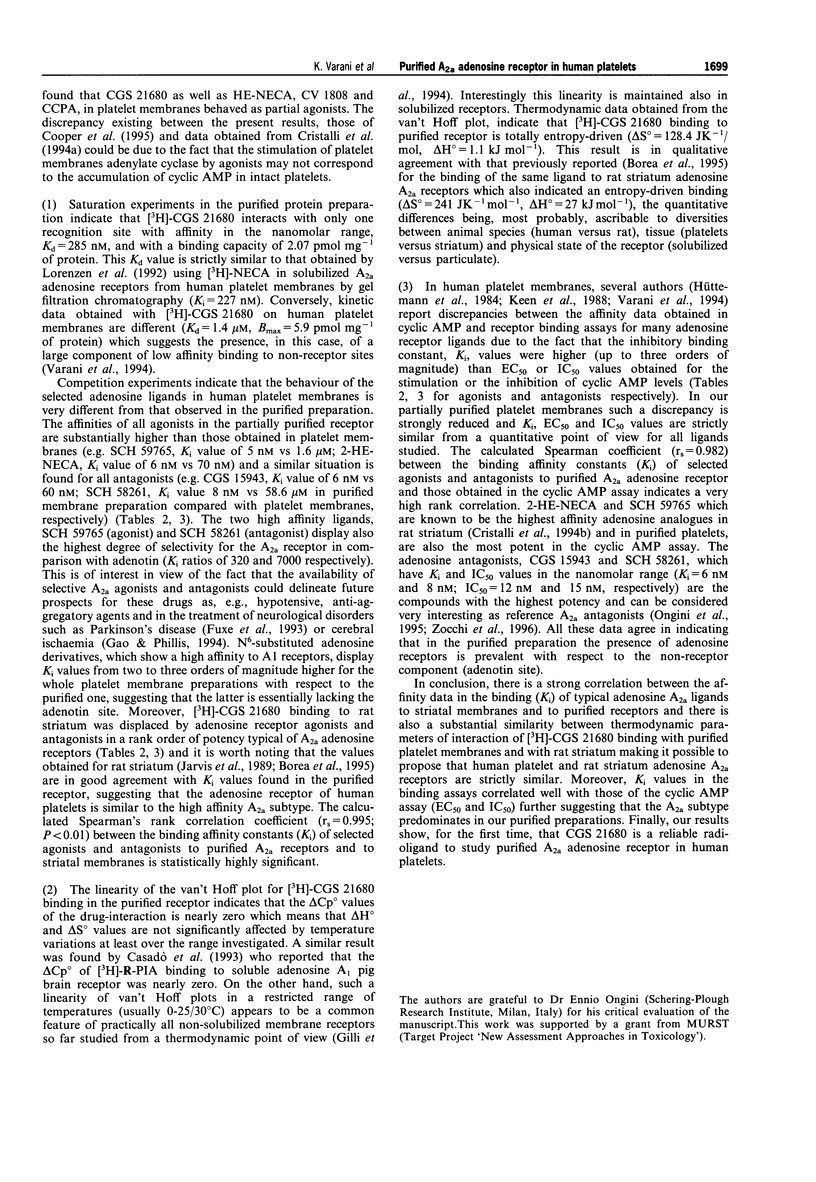
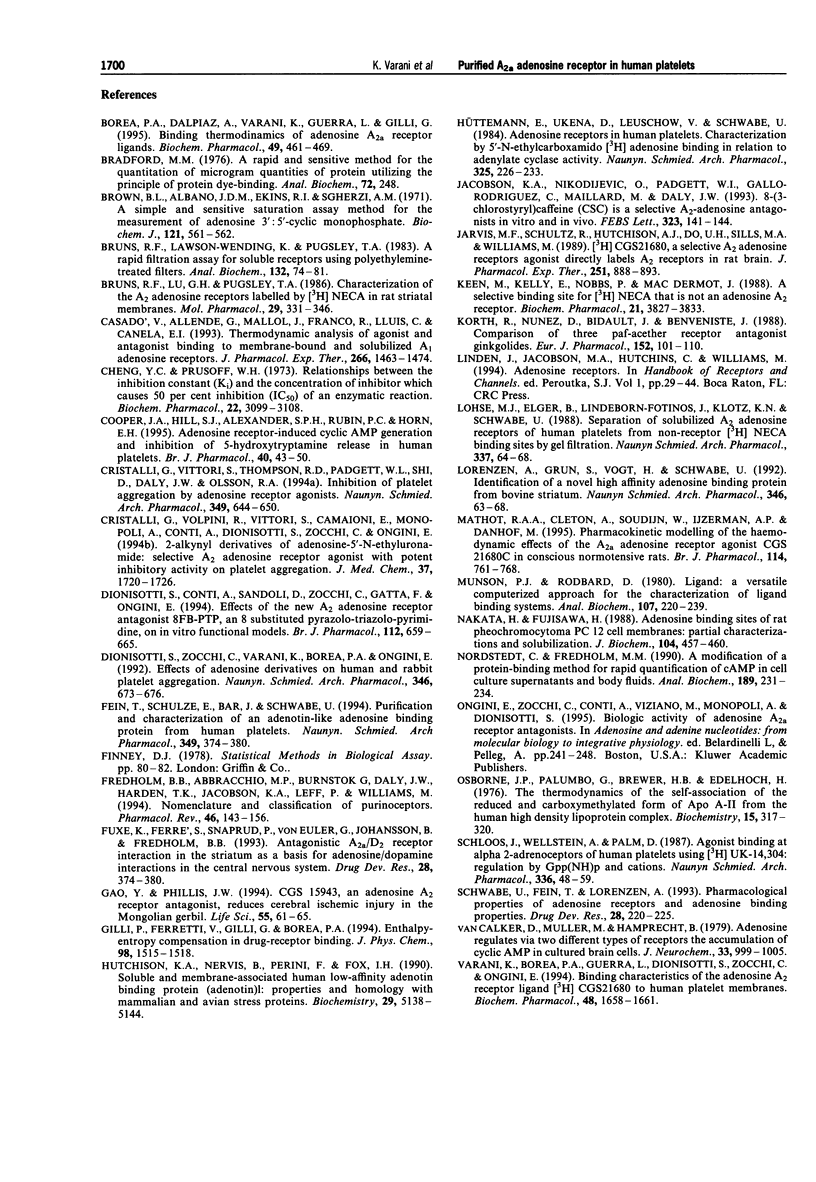

Selected References
These references are in PubMed. This may not be the complete list of references from this article.
- Borea P. A., Dalpiaz A., Varani K., Guerra L., Gilli G. Binding thermodynamics of adenosine A2a receptor ligands. Biochem Pharmacol. 1995 Feb 14;49(4):461–469. doi: 10.1016/0006-2952(94)00464-w. [DOI] [PubMed] [Google Scholar]
- Bradford M. M. A rapid and sensitive method for the quantitation of microgram quantities of protein utilizing the principle of protein-dye binding. Anal Biochem. 1976 May 7;72:248–254. doi: 10.1006/abio.1976.9999. [DOI] [PubMed] [Google Scholar]
- Brown B. L., Albano J. D., Ekins R. P., Sgherzi A. M. A simple and sensitive saturation assay method for the measurement of adenosine 3':5'-cyclic monophosphate. Biochem J. 1971 Feb;121(3):561–562. doi: 10.1042/bj1210561. [DOI] [PMC free article] [PubMed] [Google Scholar]
- Bruns R. F., Lawson-Wendling K., Pugsley T. A. A rapid filtration assay for soluble receptors using polyethylenimine-treated filters. Anal Biochem. 1983 Jul 1;132(1):74–81. doi: 10.1016/0003-2697(83)90427-x. [DOI] [PubMed] [Google Scholar]
- Bruns R. F., Lu G. H., Pugsley T. A. Characterization of the A2 adenosine receptor labeled by [3H]NECA in rat striatal membranes. Mol Pharmacol. 1986 Apr;29(4):331–346. [PubMed] [Google Scholar]
- Casadó V., Allende G., Mallol J., Franco R., Lluis C., Canela E. I. Thermodynamic analysis of agonist and antagonist binding to membrane-bound and solubilized A1 adenosine receptors. J Pharmacol Exp Ther. 1993 Sep;266(3):1463–1474. [PubMed] [Google Scholar]
- Cheng Y., Prusoff W. H. Relationship between the inhibition constant (K1) and the concentration of inhibitor which causes 50 per cent inhibition (I50) of an enzymatic reaction. Biochem Pharmacol. 1973 Dec 1;22(23):3099–3108. doi: 10.1016/0006-2952(73)90196-2. [DOI] [PubMed] [Google Scholar]
- Cooper J. A., Hill S. J., Alexander S. P., Rubin P. C., Horn E. H. Adenosine receptor-induced cyclic AMP generation and inhibition of 5-hydroxytryptamine release in human platelets. Br J Clin Pharmacol. 1995 Jul;40(1):43–50. doi: 10.1111/j.1365-2125.1995.tb04533.x. [DOI] [PMC free article] [PubMed] [Google Scholar]
- Cristalli G., Vittori S., Thompson R. D., Padgett W. L., Shi D., Daly J. W., Olsson R. A. Inhibition of platelet aggregation by adenosine receptor agonists. Naunyn Schmiedebergs Arch Pharmacol. 1994 Jun;349(6):644–650. doi: 10.1007/pl00004904. [DOI] [PubMed] [Google Scholar]
- Cristalli G., Volpini R., Vittori S., Camaioni E., Monopoli A., Conti A., Dionisotti S., Zocchi C., Ongini E. 2-Alkynyl derivatives of adenosine-5'-N-ethyluronamide: selective A2 adenosine receptor agonists with potent inhibitory activity on platelet aggregation. J Med Chem. 1994 May 27;37(11):1720–1726. doi: 10.1021/jm00037a024. [DOI] [PubMed] [Google Scholar]
- Dionisotti S., Conti A., Sandoli D., Zocchi C., Gatta F., Ongini E. Effects of the new A2 adenosine receptor antagonist 8FB-PTP, an 8 substituted pyrazolo-triazolo-pyrimidine, on in vitro functional models. Br J Pharmacol. 1994 Jun;112(2):659–665. doi: 10.1111/j.1476-5381.1994.tb13126.x. [DOI] [PMC free article] [PubMed] [Google Scholar]
- Dionisotti S., Zocchi C., Varani K., Borea P. A., Ongini E. Effects of adenosine derivatives on human and rabbit platelet aggregation. Correlation of adenosine receptor affinities and antiaggregatory activity. Naunyn Schmiedebergs Arch Pharmacol. 1992 Dec;346(6):673–676. doi: 10.1007/BF00168741. [DOI] [PubMed] [Google Scholar]
- Fein T., Schulze E., Bär J., Schwabe U. Purification and characterization of an adenotin-like adenosine binding protein from human platelets. Naunyn Schmiedebergs Arch Pharmacol. 1994 Apr;349(4):374–380. doi: 10.1007/BF00170883. [DOI] [PubMed] [Google Scholar]
- Fredholm B. B., Abbracchio M. P., Burnstock G., Daly J. W., Harden T. K., Jacobson K. A., Leff P., Williams M. Nomenclature and classification of purinoceptors. Pharmacol Rev. 1994 Jun;46(2):143–156. [PMC free article] [PubMed] [Google Scholar]
- Hutchison K. A., Nevins B., Perini F., Fox I. H. Soluble and membrane-associated human low-affinity adenosine binding protein (adenotin): properties and homology with mammalian and avian stress proteins. Biochemistry. 1990 May 29;29(21):5138–5144. doi: 10.1021/bi00473a020. [DOI] [PubMed] [Google Scholar]
- Hüttemann E., Ukena D., Lenschow V., Schwabe U. Ra adenosine receptors in human platelets. Characterization by 5'-N-ethylcarboxamido[3H]adenosine binding in relation to adenylate cyclase activity. Naunyn Schmiedebergs Arch Pharmacol. 1984 Mar;325(3):226–233. doi: 10.1007/BF00495948. [DOI] [PubMed] [Google Scholar]
- Jacobson K. A., Nikodijević O., Padgett W. L., Gallo-Rodriguez C., Maillard M., Daly J. W. 8-(3-Chlorostyryl)caffeine (CSC) is a selective A2-adenosine antagonist in vitro and in vivo. FEBS Lett. 1993 May 24;323(1-2):141–144. doi: 10.1016/0014-5793(93)81466-d. [DOI] [PMC free article] [PubMed] [Google Scholar]
- Jarvis M. F., Schulz R., Hutchison A. J., Do U. H., Sills M. A., Williams M. [3H]CGS 21680, a selective A2 adenosine receptor agonist directly labels A2 receptors in rat brain. J Pharmacol Exp Ther. 1989 Dec;251(3):888–893. [PubMed] [Google Scholar]
- Korth R., Nunez D., Bidault J., Benveniste J. Comparison of three paf-acether receptor antagonist ginkgolides. Eur J Pharmacol. 1988 Jul 26;152(1-2):101–110. doi: 10.1016/0014-2999(88)90840-0. [DOI] [PubMed] [Google Scholar]
- Lohse M. J., Elger B., Lindenborn-Fotinos J., Klotz K. N., Schwabe U. Separation of solubilized A2 adenosine receptors of human platelets from non-receptor [3H]NECA binding sites by gel filtration. Naunyn Schmiedebergs Arch Pharmacol. 1988 Jan;337(1):64–68. doi: 10.1007/BF00169478. [DOI] [PubMed] [Google Scholar]
- Lorenzen A., Grün S., Vogt H., Schwabe U. Identification of a novel high affinity adenosine binding protein from bovine striatum. Naunyn Schmiedebergs Arch Pharmacol. 1992 Jul;346(1):63–68. doi: 10.1007/BF00167572. [DOI] [PubMed] [Google Scholar]
- Mathôt R. A., Cleton A., Soudijn W., IJzerman A. P., Danhof M. Pharmacokinetic modelling of the haemodynamic effects of the A2a adenosine receptor agonist CGS 21680C in conscious normotensive rats. Br J Pharmacol. 1995 Feb;114(4):761–768. doi: 10.1111/j.1476-5381.1995.tb13270.x. [DOI] [PMC free article] [PubMed] [Google Scholar]
- Munson P. J., Rodbard D. Ligand: a versatile computerized approach for characterization of ligand-binding systems. Anal Biochem. 1980 Sep 1;107(1):220–239. doi: 10.1016/0003-2697(80)90515-1. [DOI] [PubMed] [Google Scholar]
- Nakata H., Fujisawa H. Adenosine binding sites of rat pheochromocytoma PC 12 cell membranes: partial characterization and solubilization. J Biochem. 1988 Sep;104(3):457–460. doi: 10.1093/oxfordjournals.jbchem.a122489. [DOI] [PubMed] [Google Scholar]
- Nordstedt C., Fredholm B. B. A modification of a protein-binding method for rapid quantification of cAMP in cell-culture supernatants and body fluid. Anal Biochem. 1990 Sep;189(2):231–234. doi: 10.1016/0003-2697(90)90113-n. [DOI] [PubMed] [Google Scholar]
- Osborne J. C., Jr, Palumbo G., Brewer H. B., Jr, Edelhoch H. The thermodynamics of the self-association of the reduced and carboxymethylated form of apo-a-II from the human high density lipoprotein complex. Biochemistry. 1976 Jan 27;15(2):317–320. doi: 10.1021/bi00647a012. [DOI] [PubMed] [Google Scholar]
- Schloos J., Wellstein A., Palm D. Agonist binding at alpha 2-adrenoceptors of human platelets using 3H-UK-14,304: regulation by Gpp(NH)p and cations. Naunyn Schmiedebergs Arch Pharmacol. 1987 Jul;336(1):48–59. doi: 10.1007/BF00177750. [DOI] [PubMed] [Google Scholar]
- Varani K., Borea P. A., Guerra L., Dionisotti S., Zocchi C., Ongini E. Binding characteristics of the adenosine A2 receptor ligand [3H]CGS 21680 to human platelet membranes. Biochem Pharmacol. 1994 Oct 18;48(8):1658–1661. doi: 10.1016/0006-2952(94)90212-7. [DOI] [PubMed] [Google Scholar]
- Yeung S. M., Green R. D. [3H]5'-N-ethylcarboxamide adenosine binds to both Ra and Ri adenosine receptors in rat striatum. Naunyn Schmiedebergs Arch Pharmacol. 1984 Mar;325(3):218–225. doi: 10.1007/BF00495947. [DOI] [PubMed] [Google Scholar]
- Zolnierowicz S., Work C., Hutchison K., Fox I. H. Partial separation of platelet and placental adenosine receptors from adenosine A2-like binding protein. Mol Pharmacol. 1990 Apr;37(4):554–559. [PubMed] [Google Scholar]
- van Calker D., Müller M., Hamprecht B. Adenosine regulates via two different types of receptors, the accumulation of cyclic AMP in cultured brain cells. J Neurochem. 1979 Nov;33(5):999–1005. doi: 10.1111/j.1471-4159.1979.tb05236.x. [DOI] [PubMed] [Google Scholar]


